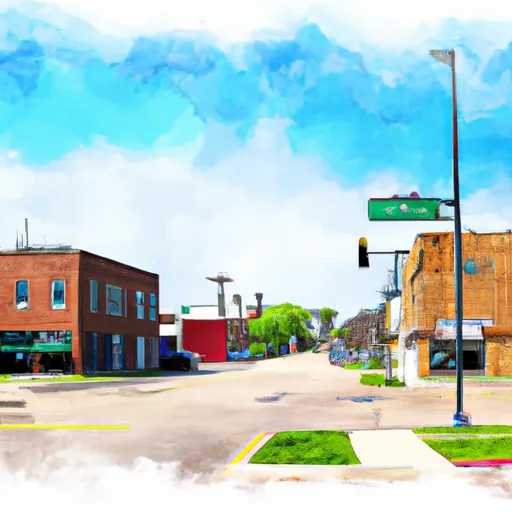-
 Snoflo Premium
Snoflo Premium
Get unlimited access to all our content
With no Ad interruptions! - Start Your Free Trial Login with existing account
Mahnomen
Eden Index
Climate
5.1
•
Recreation
0.7
•
Community
•
Safeguard
2.3/10

Mahnomen, Minnesota is a small city located in the northwest part of the state. The city experiences a humid continental climate, characterized by cold winters and warm summers. Average temperatures range from sub-zero in winter to the mid-80s in summer. Precipitation is evenly distributed throughout the year, with frequent snowfall during winter months.
Mahnomen is surrounded by several lakes, including the nearby Mahnomen Lake and Wild Rice River, which offer various hydrology constituents. These bodies of water provide opportunities for fishing, boating, and water sports. The area is known for its abundant walleye, northern pike, and perch populations, attracting avid anglers.
Outdoor enthusiasts can also explore the region's diverse landscape, which includes forests, parks, and nature reserves. Visitors can enjoy hiking, biking, and bird-watching in the surrounding areas, such as the White Earth State Forest and Smoky Hills State Forest. The Soaring Eagle Waterpark and Hotel in Mahnomen offers additional recreational activities, including water slides, pools, and arcade games. With its scenic surroundings and diverse outdoor activities, Mahnomen provides an ideal destination for nature lovers and adventure seekers alike.
What is the Eden Index?
The Snoflo Eden Index serves as a comprehensive rating system for regions, evaluating their desirability through a holistic assessment of climate health, outdoor recreation opportunities, and natural disaster risk, acknowledging the profound impact of these factors on livability and well-being.
Climate Health Indicator (CHI): 5.1
Mahnomen receives approximately
619mm of rain per year,
with humidity levels near 83%
and air temperatures averaging around
5°C.
Mahnomen has a plant hardyness factor of
3, meaning
plants and agriculture in this region thrive during a short period during spring and early summer. Most
plants will die off during the colder winter months.
By considering the ideal temperature range, reliable water supplies, clean air, and stable seasonal rain or snowpacks, the Climate Health Indicator (CHI) underscores the significance of a healthy climate as the foundation for quality living.
A healthy climate is paramount for ensuring a high quality of life and livability in a region, fostering both physical well-being and environmental harmony. This can be characterized by ideal temperatures, reliable access to water supplies, clean air, and consistent seasonal rain or snowpacks.
Weather Forecast
Streamflow Conditions
Upper Red
Area Rivers
Upper Red
Snowpack Depths
Upper Red
Reservoir Storage Capacity
Upper Red
Groundwater Levels
Recreational Opportunity Index (ROI): 0.7
The Recreational Opportunity Index (ROI) recognizes the value of outdoor recreational options, such as parks, hiking trails, camping sites, and fishing spots, while acknowledging that climate plays a pivotal role in ensuring the comfort and consistency of these experiences.
Access to outdoor recreational opportunities, encompassing activities such as parks, hiking, camping, and fishing, is crucial for overall well-being, and the climate plays a pivotal role in enabling and enhancing these experiences, ensuring that individuals can engage in nature-based activities comfortably and consistently.
Camping Areas
| Campground | Campsites | Reservations | Toilets | Showers | Elevation |
|---|---|---|---|---|---|
| Glendalough State Park | 22 | 1,350 ft | |||
| Delagoon Rec Area | 36 | 1,222 ft | |||
| Sherin Memorial City Campground | None | 1,325 ft | |||
| Tipsinah Mounds City Park | 75 | 1,170 ft | |||
| American Legion Park - Detroit Lakes | 100 | 1,342 ft | |||
| Maplewood State Park | 70 | 1,418 ft | |||
| Roseau City Park | 20 | 1,050 ft | |||
| Durgin Memorial Park | None | 1,069 ft |
Nearby Fishing
Catastrophe Safeguard Index (CSI):
The Catastrophe Safeguard Index (CSI) recognizes that natural disaster risk, encompassing floods, fires, hurricanes, and tornadoes, can drastically affect safety and the overall appeal of an area.
The level of natural disaster risk in a region significantly affects safety and the overall livability, with climate change amplifying these risks by potentially increasing the frequency and intensity of events like floods, fires, hurricanes, and tornadoes, thereby posing substantial challenges to community resilience and well-being.
Community Resilience Indicator (CRI):
The Community Resilience Indicator (CRI) recognizes that education, healthcare, and socioeconomics are crucial to the well-being of a region. The CRI acknowledges the profound impact of these elements on residents' overall quality of life. By evaluating educational resources, healthcare accessibility, and economic inclusivity, the index captures the essential aspects that contribute to a thriving community, fostering resident satisfaction, equity, and social cohesion.

